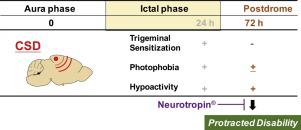Neuroscience Research ( IF 2.9 ) Pub Date : 2021-04-02 , DOI: 10.1016/j.neures.2021.03.010 Mamoru Shibata 1 , Satoshi Kitagawa 2 , Chunghua Tang 3 , Miyuki Unekawa 2 , Yohei Kayama 2 , Toshihiko Shimizu 2 , Jin Nakahara 2 , Norihiro Suzuki 4

|
Migraine sufferers often exhibit photophobia and physical hypoactivity in the postdrome and interictal periods, for which no effective therapy currently exists. Cortical spreading depolarization (CSD) is a neural phenomenon underlying migraine aura. We previously reported that CSD induced trigeminal sensitization, photophobia, and hypomobility at 24 h in mice. Here, we examined the effects of CSD induction on light sensitivity and physical activity in mice at 48 h and 72 h. Trigeminal sensitization was absent at both time points. CSD-subjected mice exhibited significantly less ambulatory time in both light (P = 0.0074, the Bonferroni test) and dark (P = 0.0354, the Bonferroni test) zones than sham-operated mice at 72 h. CSD-subjected mice also exhibited a significantly shorter ambulatory distance in the light zone at 72 h than sham-operated mice (P = 0.0151, the Bonferroni test). Neurotropin® is used for the management of chronic pain disorders, mainly in Asian countries. The CSD-induced reductions in ambulatory time and distance in the light zone at 72 h were reversed by Neurotropin® at 0.27 NU/kg. Our experimental model seems to recapitulate migraine-associated clinical features observed in the postdrome and interictal periods. Moreover, Neurotropin® may be effective in ameliorating postdromal/interictal hypoactivity, especially in a light environment.
中文翻译:

皮层扩散去极化后没有三叉神经敏化的长期活动不足:与偏头痛后遗症的相关性
偏头痛患者在发作后和间歇期经常表现出畏光和身体活动减退,目前尚无有效的治疗方法。皮质扩散去极化 (CSD) 是一种潜在的偏头痛先兆的神经现象。我们之前曾报道过,CSD 在 24 小时内诱导小鼠三叉神经致敏、畏光和活动不足。在这里,我们在 48 小时和 72 小时检查了 CSD 诱导对小鼠光敏感性和身体活动的影响。在两个时间点都不存在三叉神经致敏。在 72 小时时,接受 CSD 的小鼠在明亮(P = 0.0074,Bonferroni 测试)和黑暗(P = 0.0354,Bonferroni 测试)区域的走动时间明显少于假手术小鼠。与假手术小鼠相比,接受 CSD 的小鼠在 72 小时时在亮区的走动距离也显着缩短(P = 0.0151,Bonferroni 检验)。Neurotropin® 主要用于亚洲国家的慢性疼痛疾病的治疗。在 72 小时时,CSD 引起的光区行走时间和距离的减少被 Neurotropin® 以 0.27 NU/kg 逆转。我们的实验模型似乎概括了在发作后和发作间期观察到的与偏头痛相关的临床特征。此外,Neurotropin® 可有效改善发作后/发作间期活动减退,尤其是在光照环境中。在 72 小时时,CSD 引起的光区行走时间和距离的减少被 Neurotropin® 以 0.27 NU/kg 逆转。我们的实验模型似乎概括了在发作后和发作间期观察到的与偏头痛相关的临床特征。此外,Neurotropin® 可有效改善发作后/发作间期活动减退,尤其是在光照环境中。在 72 小时时,CSD 引起的光区行走时间和距离的减少被 Neurotropin® 以 0.27 NU/kg 逆转。我们的实验模型似乎概括了在发作后和发作间期观察到的与偏头痛相关的临床特征。此外,Neurotropin® 可有效改善发作后/发作间期活动减退,尤其是在光照环境中。



























 京公网安备 11010802027423号
京公网安备 11010802027423号